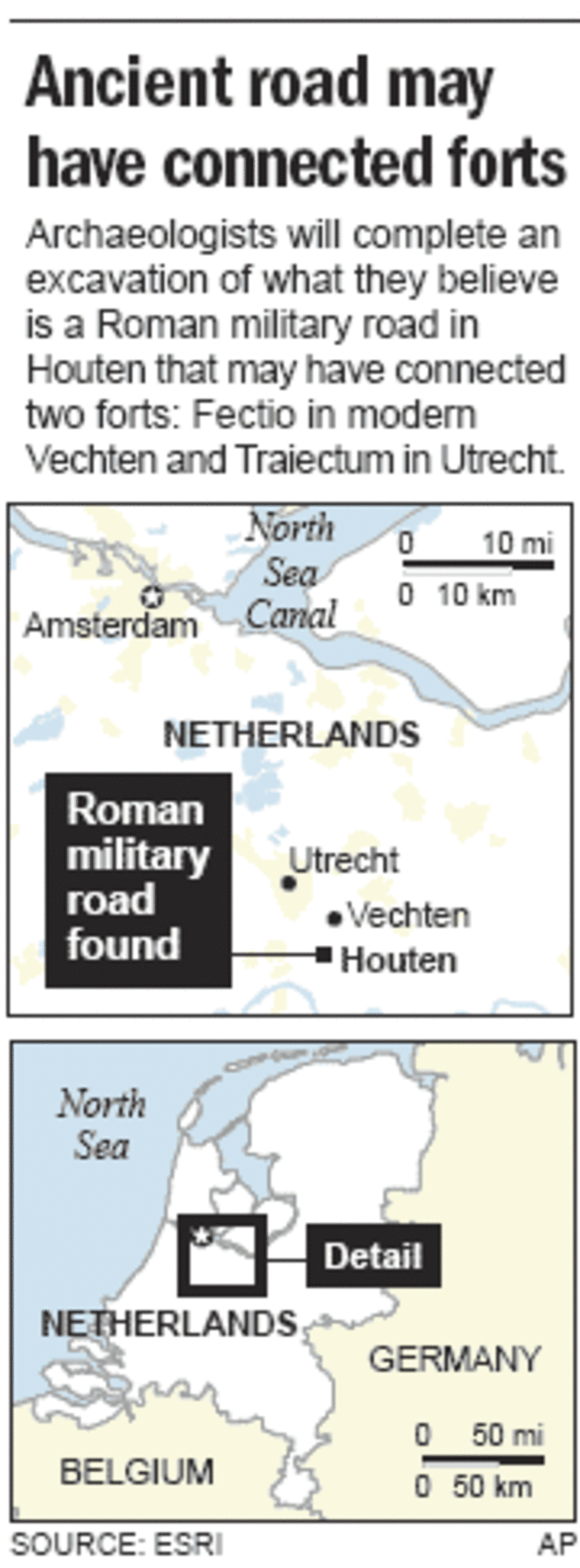Archaeologists in the Netherlands have uncovered what they believe is part of the military road Roman soldiers patrolled nearly 2,000 years ago while guarding against hostile Germanic tribes at the Roman Empire's northern boundary.
Known in Latin as the "limes," the road was in use from roughly A.D. 50 to A.D. 350, before it fell into disrepair and eventually disappeared underground, said archaeologist Wilfried Hessing, who is leading the excavations in Houten, about 30 miles southeast of Amsterdam.
The stretch of road discovered in Houten is believed to have connected two forts — Traiectum, which gives its name to the modern city of Utrecht, and Fectio, modern Vechten. Wooden poles were discovered at the site that were used to protect the roadsides from erosion, and experts hoped to use tree-ring counting techniques to determine the exact date they were cut, Hessing said.
"It was used for trade, but it was first and foremost part of a military strategy to guard the border," he said. With a road "you can respond more quickly, so you need fewer troops, just like today."

The road was discovered by the Dutch train company Prorail during preparations to add extra rail lines in the area. Hessing and Prorail will complete excavations of a short stretch in the coming weeks, then carry out exploratory digs to determine the road's route farther to the east, the city of Houton said in a statement.
"It's in very good condition," said city spokeswoman Marloes van Kessel.
Excavations of other parts of the limes are also being conducted in other European countries, and the United Nations is considering declaring it a world heritage site.
Hessing said the road was built of a sloping mound of sand and clay, interspersed with layers of gravel and smashed seashells, which would have stood about a yard above nearby fields. The top layer of hard-packed gravel is unusually well-preserved at the site.
Pottery shards were used as filler material and will help experts in dating the road, Hessing said. The road was also flanked by drainage channels, and the wooden poles were used to shore up the foundation.
Hessing said examinations of a cross-section of the road indicated it had been repaired several times. "It will be interesting to see if we can tell whether those repairs correspond with known military campaigns or were just part of standard maintenance," he said.
Romans first entered this part of the Netherlands under Julius Caesar in the year 53 B.C.
According to the Roman historian Tacitus, an uprising began in A.D. 69 when a local Germanic tribe captured two coastal forts. Roman soldiers may have retreated eastward along the road to more heavily protected forts in present-day Germany.
A year later, after first losing a battle on a flooded, marshy field near Nijmegen, the Romans pacified the Batavians, the tribe that was the main instigator of the rebellion.
Although the limes' course is known from medieval copies of ancient maps, only several segments have been found intact in the Netherlands. Archaeologists previously had been unable to determine the exact location of the limes along the Kromme, or "Crooked" Rhine, south of Utrecht because the river had changed course over time.
The find is the latest of several near Utrecht. In 2002, archaeologists found the remains of a watchtower on the Rhine where detachments of three or four Roman soldiers would have served as lookouts. Near the tower, they found bones and other remains of food the soldiers ate, as well as a spear point, coin, ax, sickle and an ancient pen.
In 2003, they uncovered a 25-yard-long barge, complete with covered living quarters and a decorated chest with lock and key. Archaeologists believe it may have been used by a paymaster to sail upriver carrying supplies to military camps and bases.
Among the items found with the barge were a knife, saw, wooden shovel, shears, copper pot, clay cups and pots, paddle with traces of blue paint, iron crowbar, leather shoe soles with studded bottoms for extra strength, and a piece of wood with Roman numbers on it.